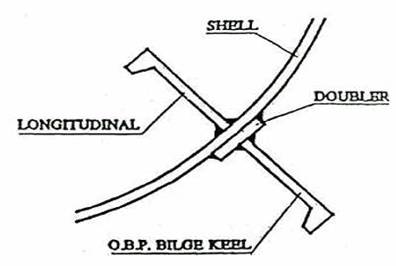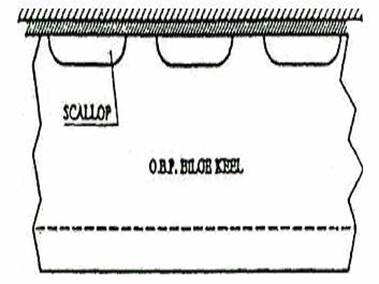Question
Describe a method for attachment of bilge keel
State 3 reasons for not extending bilge keel to the
entire length of the vessel
Explain 2 principle of roll damping that bilge keel
exploit
Answer.
A bilge keel consist of a projection from the turn of
bilge over 30% to 50% of the ships length in the midship
region. To help prevent damage to the bilge keels they are fitted within the
lines of bottom and side shell. To be effective the keel should however project
beyond the boundary layer.
The bilge keels are attached directly in line with an
internal stiffening member such as a girder or longitudinal. On thicker shell
plating (such as merchant ships) the bilge keel is made up of a flat bar doubler welded directly to the shell and an offset bulb
plate (OBP) with scallops cut in it is welded to the flat bar doubler. The ends of the bilge keels are tapered and if the
keels are positioned so that they follow the streamlines at the service speed
of the ship, then the added resistance is only about 2%.


If the keel is fitted for the full length of the
vessel it would be more difficult to construct and would be difficult to align
with flow along the hull, particularly at the fore end, causing a large
increase in resistance and fuel consumption. At the aft end, the boundary layer
is much thicker and since the keel would not project through, it would have
limited effect.
The simplest form of stabilisation, bilge keels, are often fitted even
when other more sophisticated methods of roll reduction are used. Cheap and
easy to maintain, they can provide up to 30% roll amplitude reduction and are
effective when a ship is at rest or making headway. Fitting the bilge keel to
the parallel mid-body means that it is a simple construction and gives the best
damping effect since it maximises the lever to the
axis of rotation.

A 'full form ship has a higher
natural damping coefficient than a Tine' form ship. Thus, a bilge keel fitted
to a full form ship will have less effect-than on a fine form. Furthermore,
since the bilge keel must be between the lines of side and bottom shell, it
will be constrained to a smaller size on full
form ships.